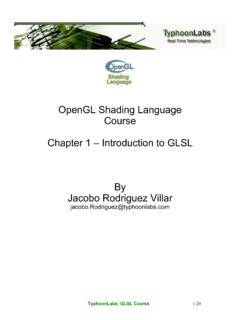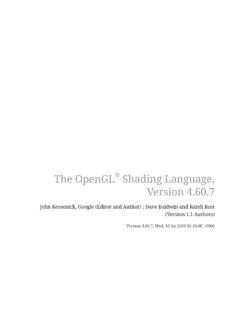Transcription of The OpenGL Utility Toolkit (GLUT) Programming Interface
1 The OpenGL Utility Toolkit ( glut ) Programming InterfaceAPI Version 3 Mark J. KilgardSilicon Graphics, 13, 1996 OpenGL is a trademark of Silicon Graphics, Inc. X Window System is a trademark of X Consortium, is a registered trademark of Spatial Systems author has taken care in preparation of this documentation but makes no expressed or implied warrantyof any kind and assumes no responsibility for errors or omissions. No liability is assumed for incidental orconsequential damages in connection with or arising from the use of information or programs contained 1994, 1995, 1996. Mark J. Kilgard. All rights rights reserved. No part of this documentation may be reproduced, in any form or by any means, withoutpermission in writing from the Version 2 Version 3 :::::::::::::::::::::::::::::::::::::::: ::42 , ::::::::::::::::::::::::::::::::::::::73 Beginning Event :::::::::::::::::::::::::::::::::::::::: :84 Window , glutPopWindow, glutShowWindow, glutHideWindow, glutSetWindowTitle, glutSetCursor::::::::::::::::::::::::::: ::::::::::::::135 Overlay , glutHideOverlay::::::::::::::::::::::::: :::::166 Menu , , glutDetachMenu:::::::::::::::::::::::::: :::::19iiCONTENTS7 Callback , glutTimerFunc.
2 288 Color Index Colormap :::::::::::::::::::::::::::::::::::::::3 09 State ::::::::::::::::::::::::::::::::::::3310 Font glutStrokeWidth::::::::::::::::::::::::: :::::::::::::::3611 Geometric Object glutSolidSphere, glutSolidCube, glutSolidCone, glutSolidTorus, glutSolidDodecahedron, glutSolidOctahedron, glutSolidTetrahedron, glutSolidIcosahedron, glutSolidTeapot, glutWireTeapot:::::::::::::::::::::::::: ::::::3912 Usage Advice39 CONTENTSiii13 FORTRAN Names for the FORTRAN glut Font Naming NULL Callback:::::::::::::::::::::::::::::::: ::::::::4214 Implementation Name Space Modular Error Checking and Avoid Unspecified glut Usage Restrictions:::::::::::::::::::::::::42A glut Types of Global Window Menu State::::::::::::::::::::::::::::::::::: ::::::::48B ANSI C Header File49C FORTRAN Header File55 References60 Index61ivCONTENTS11 IntroductionThe OpenGL Utility Toolkit ( glut ) is a Programming Interface with ANSI C and FORTRAN bindings for writ-ing window system independent OpenGL programs.
3 The Toolkit supports the following functionality: Multiple windows for OpenGL rendering. Callback driven event processing. Sophisticated input devices. An idle routine and timers. A simple, cascading pop-up menu facility. Utility routines to generate various solid and wire frame objects. Support for bitmap and stroke fonts. Miscellaneous window management functions, including managing ANSI C implementation of glut for the X Window System [15] has been implemented by the NT and OS/2 versions of glut are also documentation serves as both a specification and a Programming guide. If you are interested in a briefintroduction to Programming with glut , look for the introductory OpenGL column [9] published inThe XJournal. For a complete introduction to using glut , obtain the bookProgramming OpenGL for the X WindowSystem[10].
4 glut is also used by the 2nd edition of theOpenGL Programming Guide. Teachers and studentsinterested in using glut in conjunction with a college-level computer graphics class should investigate An-gel s textbookInteractive Computer Graphics: A top-down approach with OpenGL [2] that uses glut for itsOpenGL-based examples remainder of this section describes glut s design philosophy and usage model. The following sectionsspecify the glut routines, grouped by functionality. The final sections discuss usage advice, the FORTRAN binding, and implementation issues. Appendix A enumerates and annotates the logical programmer visible statemaintained by glut . Appendix B presents the ANSI C glut API via its header file. Appendix C presents theFORTRANGLUT API via its header BackgroundOne of the major accomplishments in the specification of OpenGL [16, 12] was the isolation of window systemdependencies from OpenGL s rendering model.
5 The result is that OpenGL is window system system operations such as the creation of a rendering window and the handling of window systemevents are left to the native window system to define. Necessary interactions between OpenGL and the windowsystem such as creating and binding an OpenGL context to a window are described separately from the OpenGLspecification in a window system dependent specification. For example, the GLX specification [4] describes thestandard by which OpenGL interacts with the X Window predecessor to OpenGL is IRIS GL [17, 18]. Unlike OpenGL , IRIS GLdoesspecify how renderingwindows are created and manipulated. IRIS GL s windowing Interface is reasonably popular largely because itis simple to use. IRIS GL programmers can worry about graphics Programming without needing to be an expertin Programming the native window system.
6 Experience also demonstrated that IRIS GL s windowing interfacewas high-level enough that it could be retargeted to different window systems. Silicon Graphics migrated fromNeWS to the X Window System without any major changes to IRIS GL s basic windowing window system operations from OpenGL is a sound decision because it allows the OpenGLgraphics system to be retargeted to various systems including powerful but expensive graphics workstations aswell as mass-production graphics systems like video games, set-top boxes for interactive television, and , the lack of a window system Interface for OpenGL is a gap in OpenGL s Utility . Learningnative window system APIs such as the X Window System s Xlib [7] or Motif [8] can be daunting.
7 Even thosefamiliar with native window system APIs need to understand the Interface that binds OpenGL to the native21. INTRODUCTION window system. And when an OpenGL program is written using the native window system Interface , despitethe portability of the program s OpenGL rendering code, the program itself will be window system and documenting OpenGL s functionality lead to the development of thetkandauxtoolkits. Theauxtoolkit is used in the examples found in theOpenGL Programming Guide[11]. Unfortunately,auxhasnumerous limitations and its Utility is largely limited to toy programs. Thetklibrary has more functionalitythanauxbut was developed in anad hocfashion and still lacks much important functionality that IRIS GLprogrammers expect, like pop-up menus and is designed to fill the need for a window system independent Programming Interface for OpenGLprograms.
8 The Interface is designed to be simple yet still meet the needs of useful OpenGL programs. Featuresfrom the IRIS GL,aux,andtkinterfaces are included to make it easy for programmers used to these interfacesto develop programs for Design PhilosophyGLUT simplifies the implementation of programs using OpenGL rendering. The glut application program-ming Interface (API) requires very few routines to display a graphics scene rendered using OpenGL . The GLUTAPI (like the OpenGL API) is stateful. Most initial glut state is defined and the initial state is reasonable forsimple glut routines also take relatively few parameters. No pointers are returned. The only pointers passedinto glut are pointers to character strings (all strings passed to glut are copied, not referenced) and opaquefont glut API is (as much as reasonable) window system independent.
9 For this reason, glut does notreturnanynative window system handles, pointers, or other data structures. More subtle window system de-pendencies such as reliance on window system dependent fonts are avoided by glut ; instead, glut suppliesits own (limited) set of Programming ease, glut provides a simple menu sub-API. While the menuing support is designed tobe implemented as pop-up menus, glut gives window system leeway to support the menu functionality inanother manner (pull-down menus for example).Two of the most important pieces of glut state are thecurrent windowandcurrent menu. Most windowand menu routines affect thecurrent windowormenurespectively. Most callbacks implicitly set thecurrentwindowandmenuto the appropriate window or menu responsible for the callback.
10 glut is designed so that aprogram with only a single window and/or menu will not need to keep track of any window or menu greatly simplifies very simple glut is designed for simple to moderately complex programs focused on OpenGL rendering. glut im-plements its own event loop. For this reason, mixing glut with other APIs that demand their own event han-dling structure may be difficult. The advantage of a builtin event dispatch loop is contains routines for rendering fonts and geometric objects, however glut makes no claims on theOpenGL display list name space. For this reason,none of the glut rendering routines use OpenGL displaylists. It is up to the glut programmer to compile the output from glut rendering routines into display listsif this is routines are logically organized into several sub-APIs according to their functionality.







